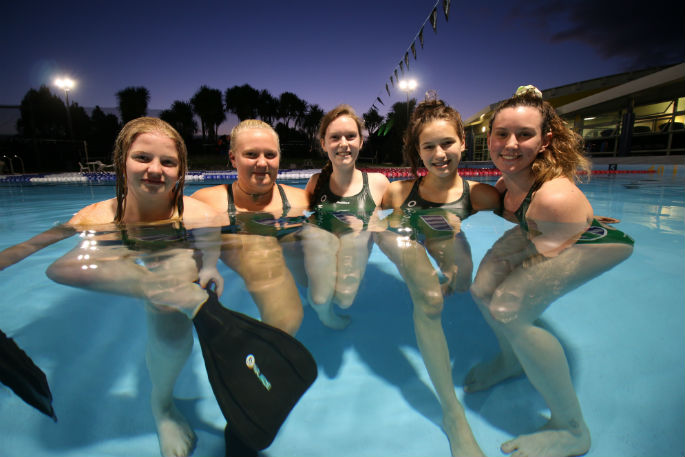It all began with a cheap shot at a sausage sizzle outside Mitre 10 last Saturday morning.
'Underwater hockey?” asked The Weekend Sun. 'We spend thousands of dollars on artificial hockey pitches and you want to play on the bottom of a swimming pool. Why?”
Seventeen-year-old Adriana Lipinsky is primed for that sort of ill-considered scrutiny of her chosen sport, her love. 'Go look it up, go Google it,” shoots back the no-nonsense Adriana.
But apparently a lot of people, just about everyone at the sausage sizzle – no onions of course – asked the same question. 'It made me feel a bit stink,” says the Otumoetai College girls' underwater hockey squad member. 'But at the same time l appreciated the opportunity to educate people about underwater hockey and show them how passionate we are.”
And for its sins, and on the strength of being put in our place by a teenager, a sheepish Weekend Sun reporter and photographer found themselves at training night – an open air pool at Toi Ohomai at Windermere - the air temperature is 11 or 12 degrees, the water temperature a mildly more agreeable 28.
'Perfect, I made you feel guilty,” says Adriana. She has scored some exposure for her sport.
The coach is in a puffer jacket. The girls are in togs. They're hardy and committed these water babies. One-and-a-half-hour training sessions twice a week. They play in Rotorua on Wednesday nights, club night is Sunday and land-based training first thing Monday. And next week they're off to the nationals at Kilbirnie in Wellington. That's why The Weekend Sun flicked them a couple of dollars at the sizzle.
Underwater hockey started with a sub-aqua club in Portsmouth, England 65 years ago. The British navy invented it to keep divers fit and improve their mobility and efficiency under water. It morphed into 'a fast, dynamic sport” played in more than 20 countries.
The Sun took Adriana's cue and did some research – two teams of up to ten players, six players at any one time in the pool. The remaining four players are rolling subs.
The puck is placed in the centre of the pool and the players wait against the wall above the goal they are defending. At the buzzer, players are free to swim anywhere to manoeuvre the puck into the opponents' goal. When a goal is scored, players return to their wall to start a new point. And take a breath.
The Otumoetai girls can apparently hold their breath for up to two minutes when they're stationary and 30 seconds or more when they're playing, when their bodies are under stress. That's a long time when someone doesn't have the lung capacity. But it's what the girls train for.
Seventeen-year-old Sarah Dixon has always loved the water, loved swimming. But she and competitive swimming didn't agree. So she submerged. 'Went to a club night at intermediate and underwater hockey and I fell in love.” It was more of a natural progression for Adriana Lipinsky. 'I played field hockey and also loved swimming and so when ‘Have-A-Go' was advertised at intermediate school I was like: ‘ooohh!' So tried it and fell in love.”
What's with all the love, why does holding your breath on the bottom of a swimming pool induce such deep-seated emotion? Apparently it comes with the inability to communicate during a game. 'You kind of connect to each other outside the pool, because we can't communicate inside it,” explains Adriana.
Sarah suggests the team is almost telepathic - conveying thoughts and ideas without using the known senses. 'We can just look at one another and know exactly what's going on. That happens underwater and when we get out of the pool. We can look at each other across the school yard and know what's going down.”
It's what helps to make the underwater hockey team family rather than just a team. This family has grown together over five or six years. It's really close.
Kelly Saunders is mother to the family – she's coach. She fell in love too – loved the water, loved water polo and then fell in love with underwater hockey. 'It's just an extra community you can belong to, friends I suspect I will have forever.”
It's an odd sport and coach Kelly appreciates it's an odd sport. 'But it's infectious – you keep coming back.” That attachment might be tested when training is on a cold Tuesday evening in the dead of winter. 'That's my job – keep them motivated, keep them in shape, keep them motivated. They have their moments like all teenagers but they're a great bunch of kids.”
But this bunch is short a few kids. The squad is eight strong but could do with 10 or eleven players. Why aren't kids buying into underwater hockey? 'Probably because it doesn't get the same exposure in the media as mainstream sports.” It's a minority sport and people just don't know about it. And perhaps because it's played on the bottom of a swimming pool, it's not a spectator sport. Probably its biggest weakness.
At some tournaments they have underwater cameras and the action is replayed on a big screen. Team manager Lynda Dixon says at smaller tournament the emotion still runs.
'Everyone will be right at the edge of the pool shouting and screaming. The crowds do go mad – most of them parents.”
And Lynda appeals to people to give underwater hockey a go. 'You don't have to have been playing it since you were five. You can pick it up at any stage and do well because it's a minority sport. You aren't competing with thousands of others.”
If you would like to join the Otumoetai College girls' underwater hockey squad or help pay their way to the nationals next week message Lynda at jonandlyndixon@gmail.com

